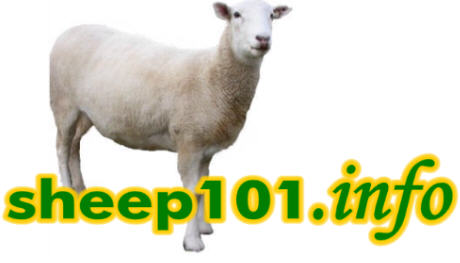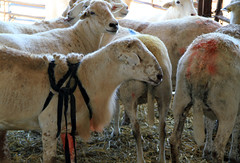 Breeding season
Breeding season

Lambing on pasture
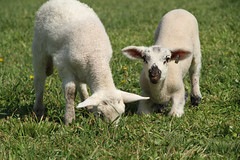
Spring is for lambs
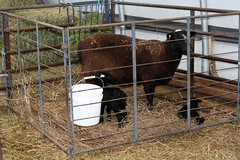
Lambing jug
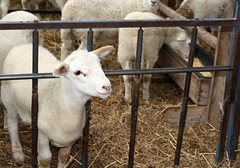
Creep pen
|
A day in the life of a sheep
How sheep are raised varies by farm (or ranch), geographic region, and
production system. On this page, you'll learn
what it's like to be a sheep on the farm where George
lived: The Baalands in Clear
Spring, Maryland USA.
Breeding
At the Baalands, the "sheep year" begins in the middle
of October when the rams are put in with the ewes for breeding.
Only one ram is put in with a group of ewes so that the sire of
the lambs will be known. The rams are switched around after the
first and second heat cycles in case some ewes do not become pregnant after being exposed to the first ram.
With fall breeding, most ewes will get pregnant within the first 17 days of the breeding
season. This is the average length of one estrus (heat) cycle.
Fertility is high when breeding is during the most natural time
(fall). The flock will stay on pasture until the grass is depleted,
usually around Christmas time, earlier if it was a drought year.
Winter housing
During the winter months, the sheep are housed in a "hoop
house," a greenhouse-like structure with an arched metal
frame and a fabric covering. They are fed grass hay. They are
allowed out to pasture for exercise. Rams are maintained separately. It's never a good idea to leave rams with ewes after breeding is done.
Extra feed
Starting in late-February, grain is added to the ewes'
diet to support the growth of their fetuses and development of
their mammary tissue. About four weeks prior to the start of lambing
season, the ewes are vaccinated for clostridium perfringins
type C and D (overeating disease) and tetanus so that their lambs
will receive immunity when they drink the colostrum.
No shearing
Wooled sheep are usually sheared prior to lambing or in the spring before the onset of hot weather.
Katahdin sheep at the Baalands naturally shed their coats, a mixture
of hair and wool fibers, so shearing is not necessary. In fact, lambs will generally shed their coats their
first year.
Lambing
Lambing usually starts in the middle of March. Yearling ewes are bred
to lamb three weeks later. Ewes give birth to lambs in a
large "drop" pen. Sometimes, if the weather is nice, the ewes
will have their lambs outside. Ewes almost always lamb on their
own, without any assistance or interference from the shepherd. Most
of the ewes give birth to twins or triplets, sometimes quadruplets. The lambs are quick
to get up and have their first meal.
Jugging
After a litter of lambs is born, they are put in a small pen (5
ft. x 5 ft.) called a "jug" with their dam (mother). Their navel cords are shortened, if necessary, and sprayed or dipped into a disinfectant, usually betadine. Being
together in the jug helps the lambs and ewe bond and provides
for easy observation by the shepherd. One the second day, the
lambs are weighed and ear-tagged. The birth date, sex, weight,
and ear tag number of each lamb is recorded. At the Baalands,
lambs are not docked or castrated. Docking would be a common practice on farms where wooled breeds are raised. Lambs will generally stay in
the jugs for 1 to 3 days.
Mixing pens
After several days, the lambs and ewes are moved to mixing pens:
larger pens with approximately four ewes and their lambs.
After
being butted a few times by other ewes, the lambs quickly learn
how to recognize their own mothers. Once they get used to each
other, the lambs will huddle together to sleep and keep warm.
Twins and triplets
After a week or two in the mixing pens, groups of lambs and ewes
are put with the rest of the ewes and their lambs. The lambs will
be able to go anywhere in the barn. Ewes nursing triplet lambs
are penned separately from ewes nursing twins, because they
receive extra grain to produce milk for their extra lamb.
Creep feeding
By the time the lambs are two weeks old, they will have access
to a creep area for creep feeding. A creep is a pen that is fenced
so that young animals can enter but adults cannot. Creep feed
is feed given to young nursing lambs. At the Baalands, the creep
feed is a mixture of soybean meal and cracked corn. The lambs
will also have access to fresh water, high quality hay, and minerals
in the creep area. Even when they are not eating, the creep area
is a place where the lambs like to hang out.
MORE ==>
<= RAISING SHEEP
|
